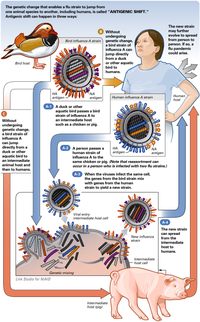H1N1 VIRUS
>> Sunday, May 24, 2009
Influenza A virus subtype H1N1, also known as A(H1N1), is a subtype of influenzavirus A and the most common cause of influenza (flu) in humans. Some strains of H1N1 are endemic in humans, including the strain(s) responsible for the 1918 flu pandemic which killed 50–100 million people worldwide. Less virulent H1N1 strains still exist in the wild today, worldwide, causing a small fraction of all influenza-like illness and a large fraction of all seasonal influenza. H1N1 strains caused roughly half of all flu infections in 2006.[1] Other strains of H1N1 are endemic in pigs and in birds.
In March, April and May 2009, thousands of laboratory-confirmed infections and a number of deaths were caused by an outbreak of a new strain of H1N1.
Influenza A virus strains are categorized according to two proteins found on the surface of the virus: hemagglutinin (H) and neuraminidase (N). All influenza A viruses contain hemagglutinin and neuraminidase, but the structure of these proteins differs from strain to strain due to rapid genetic mutation in the viral genome.
Influenza A virus strains are assigned an H number and an N number based on which forms of these two proteins the strain contains. There are 16 H and 9 N subtypes known in birds, but only H 1, 2 and 3, and N 1 and 2 are commonly found in humans.[4]
2009 Influenza A(H1N1) outbreak
Illustration of influenza antigenic shift.
Main article: 2009 swine flu outbreak
Minor outbreaks of swine influenza occurred in humans in 1976 and 1988, and in pigs in 1998 and 2007.
In the 2009 swine flu outbreak, the virus isolated from patients in the United States was found to be made up of genetic elements from four different flu viruses – North American Mexican influenza, North American avian influenza, human influenza, and swine influenza virus typically found in Asia and Europe – "an unusually mongrelised mix of genetic sequences."[14] This new strain appears to be a result of reassortment of human influenza and swine influenza viruses, in all four different strains of subtype H1N1. However, as the virus has not yet been isolated in animals to date and also for historical naming reasons, the World Organisation for Animal Health (OIE) suggests it be called "North-American influenza".[15] On April 30, 2009 the World Health Organization began referring to the outbreak as "Influenza A" instead of "swine flu".[16], and later began referring to it as "Influenza A(H1N1)". Several complete genome sequences for U.S. flu cases were rapidly made available through the Global Initiative on Sharing Avian Influenza Data (GISAID).[17][18] Preliminary genetic characterization found that the hemagglutinin (HA) gene was similar to that of swine flu viruses present in U.S. pigs since 1999, but the neuraminidase (NA) and matrix protein (M) genes resembled versions present in European swine flu isolates. The six genes from American swine flu are themselves mixtures of swine flu, bird flu, and human flu viruses.[19][20] While viruses with this genetic makeup had not previously been found to be circulating in humans or pigs, there is no formal national surveillance system to determine what viruses are circulating in pigs in the U.S.[21]
0 comments:
Post a Comment